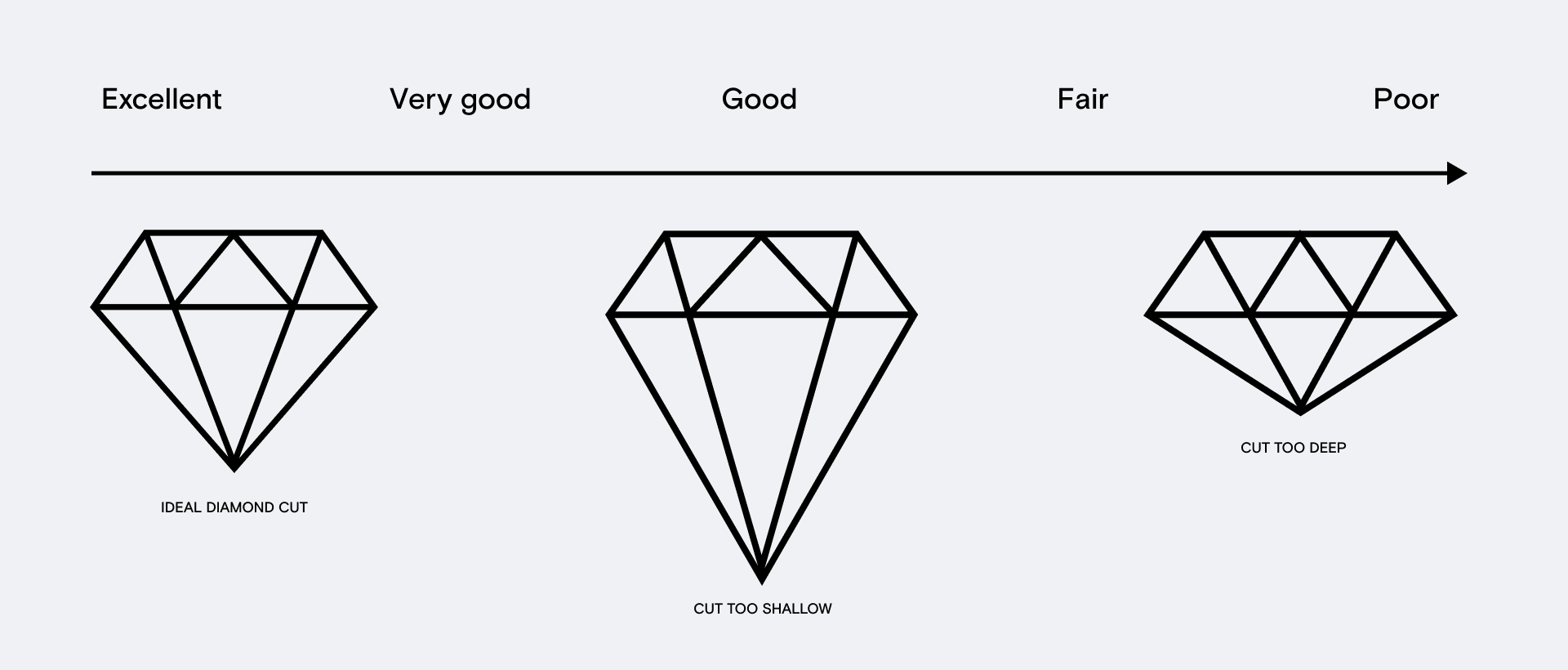Written by Clem | 18 October 2023
The ‘4 Cs’ stand for colour, clarity, carat and cut and “the combination of these four factors determine the quality and therefore, the price of a diamond”, says Claudia. A trained gemologist like her can measure all factors with two pieces of equipment: a precise weighing scale and a microscope or a loupe (a small magnifying glass with 10x magnification). The diamond industry is standardised, so you can rest assured that any of the ‘4 Cs’ are the same all over the world.
Colour
 Diamonds - Colour scale
Diamonds - Colour scale
This colour scale only refers to ‘white’ or ‘colourless’ diamonds – there are other colour scales for fancy coloured diamonds and other gemstones. All diamonds are graded in the range ‘D’ to ‘Z’, with ‘D’ being completely colourless. Claudia explains, “imagine a ‘D’ diamond as a clear glass of water. For every letter down the scale, take a tea bag and dip it in the water. Maybe you’d dip the bag for a second to get an ‘E’ colour, and each second longer would take it down a grade.”
Diamonds are graded on the following scale:
- ‘D’-‘F’ – technically colourless
- ‘G’-‘J’ – near colourless, no visible colour to the naked eye
- ‘K’-‘M’ – a faint hue
- ‘N’-‘R’ – very light hue visible
- ‘S’-’Z’ – light coloured, appears yellow, brown or grey
When searching for diamonds on Catawiki, consider how ‘white’ you really want it to be – if you want a larger stone, sacrificing slightly on the colour may be the easiest way to keep it affordable.
 Diamonds - clarity scale
Diamonds - clarity scaleClarity is the measurement of visible imperfections when looking inside the stone. When a gemologist determines the clarity of a diamond, the stone must be inspected under 10x magnification for clarity characteristics, also commonly known as "inclusions". After inspection, the diamond can be categorised into one of these grades:
- ‘Flawless (FL)’ and ‘Internally flawless (IF)’ – no internal characteristics present in the stone, incredibly rare and not generally seen in commercial jewellery
- ‘VVS1’ and ‘VVS2’ – very very slightly included, very difficult for a trained gemologist to see
- ‘VS1’ and ‘VS2’ – very slightly included, difficult for a trained gemologist to see
- ‘SI1’ and ‘SI2’ – slightly included, fairly easy for a trained gemologist to see
- ‘I1’. ‘I2’ and ‘I3’ – included, visible characteristics to the naked eye
“A ‘VS’ diamond looks great to the naked eye in jewellery.” When bidding for yourself, stones with slight inclusions are a more affordable option – and they’re often just as sparkly as a clearer stone.
Carat
 Diamonds - carat scale
Diamonds - carat scale
The most simple measurement for the uninitiated, the carat (ct) is the weight of a diamond. One carat equals 200 milligrams, so five carats is one gram. Carat weight is measured to the nearest hundredth, for example 0.30 ct (also known as 30 point) or 1.50 ct. The larger the diamond and the heavier the carat weight, the higher its value.
For scale, when looking for your own diamonds, the average solitaire engagement ring is set with a diamond between 0.50 and 1.00 ct.
Cut
 Diamonds - cut scale
Diamonds - cut scale
“The cut is the only feature of a diamond not dependent on Mother Nature,” Claudia explains. From raw material to finished product, a cutter works to create facets in the stone. “Imagine the facets as mirrors that are angled in a very specific way, in order to reflect the light and make a diamond look more alive.”
Diamond cuts are graded in quality:
- ‘Excellent’
- ‘Very good’
- ‘Good’
- ‘Fair’
- ‘Poor’
Polish, proportion and symmetry are vital for how light travels through the stone, determining the cut quality. An ‘SI’, ‘K’ colour diamond can be made more brilliant with an excellent cut.
Lastly, the cut style plays an important role. Antique diamonds were not cut in a uniform fashion, but renowned Belgian diamond specialist Marcel Tolkowsky introduced standardisation in 1919, resulting in the ‘round brilliant’ style. He showed cutters the perfect proportions to “enhance the brilliance of a diamond”, and this is still how most diamonds are cut.
‘Round brilliant’ diamonds remain the most popular in the world, but other cuts, such as ‘oval’, ‘cushion’, ‘princess’ and even ‘heart shape’ are commonly available. When searching for a diamond, think about the shape you like first and then assess the quality of the cut, so you can make sure you’re getting the most sparkle.
Choosing your diamond
When buying your own diamond, Claudia stresses that the combination of all ‘4 C’s is’ what determines a diamond’s value. “You could have a 0.80 ct diamond, which you’d think would be expensive, but the other three ‘Cs’ are low quality, reducing the price.”
All these measurements can be found on a diamond’s certificate. This classification is required for stones worth over €2,000 and is common for other diamonds, too. Now you’re ready to find your perfect diamond, happy searching.
____________________
Find diamonds of all cuts, sizes and styles in our Jewellery and Precious Stones auctions.
You might also like:
The most expensive diamonds in the world
Discover the meaning behind your birthstone
How women are changing the gemstones industry